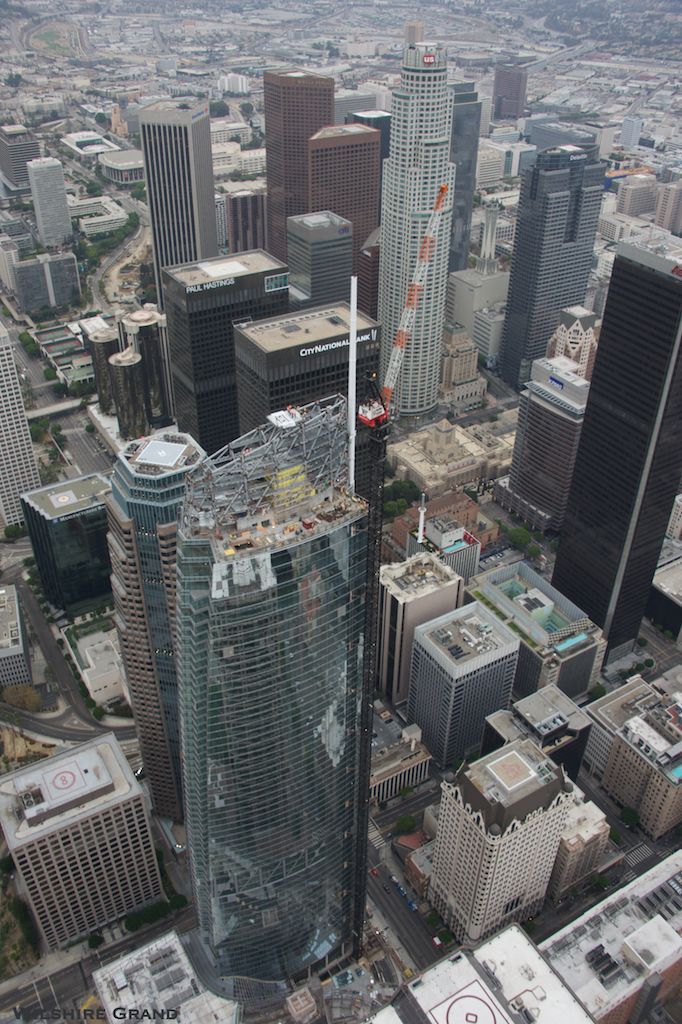It’s wrapped in a glass that generated a “death ray” on the Vegas Strip
Fearless construction workers are installing the final glass panels on the Wilshire Grand, whose spire crests above the US Bank Tower just high enough to surpass it as the tallest building in Los Angeles.
That glass, a product called VRE 1-38, cloaks the entire tower, and it’s dazzling. But it has caused serious problems elsewhere. In Las Vegas, the Vdara Hotel has a VRE 1-38 skin, and it reflects a beam of light onto a pool deck that’s not only super bright but also super hot—it singed one bather’s hair and melted plastic cups. The beam is so notorious, it has a nickname: the “death ray.”
The owners of a shorter, 41-story building right next to the Wilshire Grand say the glass has also become a nuisance and a hazard in LA. It has requested the city revoke building permits and mandate that all of the glass be stripped off.
But an expert who analyzed glare on the Walt Disney Concert Hall tells Curbed that while the glass on the Wilshire Grand might create some annoying and potentially blinding glare, it’s not about to shoot a death ray.
“There might be visual problems, but none of that serious heat stuff,” said Marc Schiler, a professor at USC’s school of architecture.
Schiler checked out the Vdara beam, and in 2004, wrote a report for the county on what was causing the glare at Frank Gehry’s undulating Walt Disney Concert Hall. (Schiler also figured out how to fix it; he buffed the steel facade with sandpaper to diffuse the “focus points without changing the reflectiveness.”)
Those curves, both for the Vdara and the concert hall, were the problem. For a shiny facade to generate enough heat to burn something, it has to be concave, meaning it curves inward, Schiler said. Here’s how he explains it:
So one can have a 6,000 square foot façade that throws the reflected heat over a 6,000 square foot area. Or one can have a 6,000 square foot façade that throws all of its sunlight on six square feet. The concave surface can do the latter. As you can guess, the temperature on the six square foot spot is much, much higher. (1,000 times as much energy is being poured onto it.)
The Wilshire Grand, which is being developed by Korean Air, is convex, so while the light it reflects might warm things up a bit, it won’t burn anything, Schiler said.
But the owners of the Ernst & Young Plaza, just south of the Wilshire Grand, claim the new glimmering facade is creating “thermal heat gain” at its plaza. Over the summer, their attorney sent several letters to the city’s building department about the issue. In one, they say it’s generating “excessive heat and glare on nearby streets,” posing a danger to drivers and pedestrians, according to Law360.
The Los Angeles Times says the owners of EYP also accused the Wilshire Grand of violating its conditions of approval by picking a “very reflective glass.” The building department issued its own report last week saying it was not in violation, according to the Times.
 Gary Leonard, courtesy Wilshire Grand Center
Gary Leonard, courtesy Wilshire Grand CenterLisa Gritzner, a spokeswoman for Wilshire Grand architect AC Martin, says removing all of the glass would be an extreme solution.
Vdara’s owner MGM Resorts solved its problem by placing big blue umbrellas across the pool deck to protect bathers. AC Martin hired an architect, George Loisos, to evaluate EYP’s claims about the Wilshire Grand. In his report, he suggested the solution could be just as simple.
“It would be expected that the occupants of the north-facing offices, who never received any direct sunlight, would notice the different conditions when light was reflected off the Wilshire Grand building,” he says.
“The simple solution for the north-facing office is to utilize interior window shades.”
- LA Tower Allegedly Using Vegas ‘Death Ray’ Glass [Law 360]
- Watch the Wilshire Grand get its spire, making it the tallest building in Los Angeles [Curbed LA]
